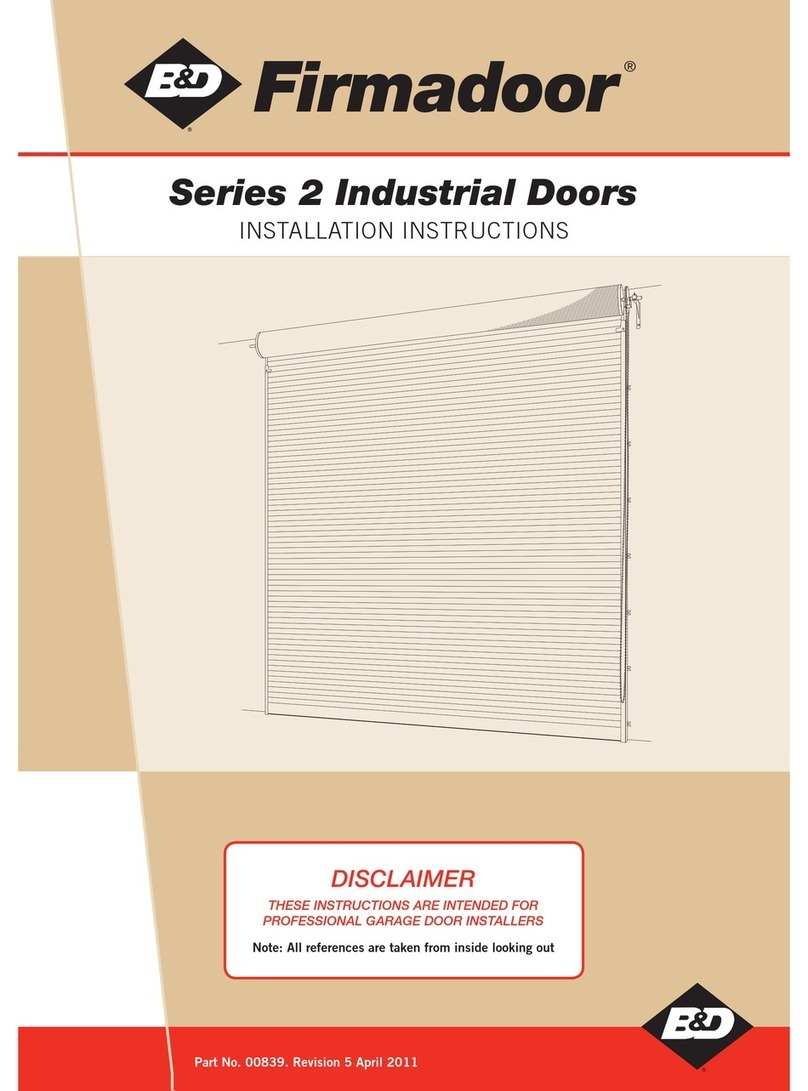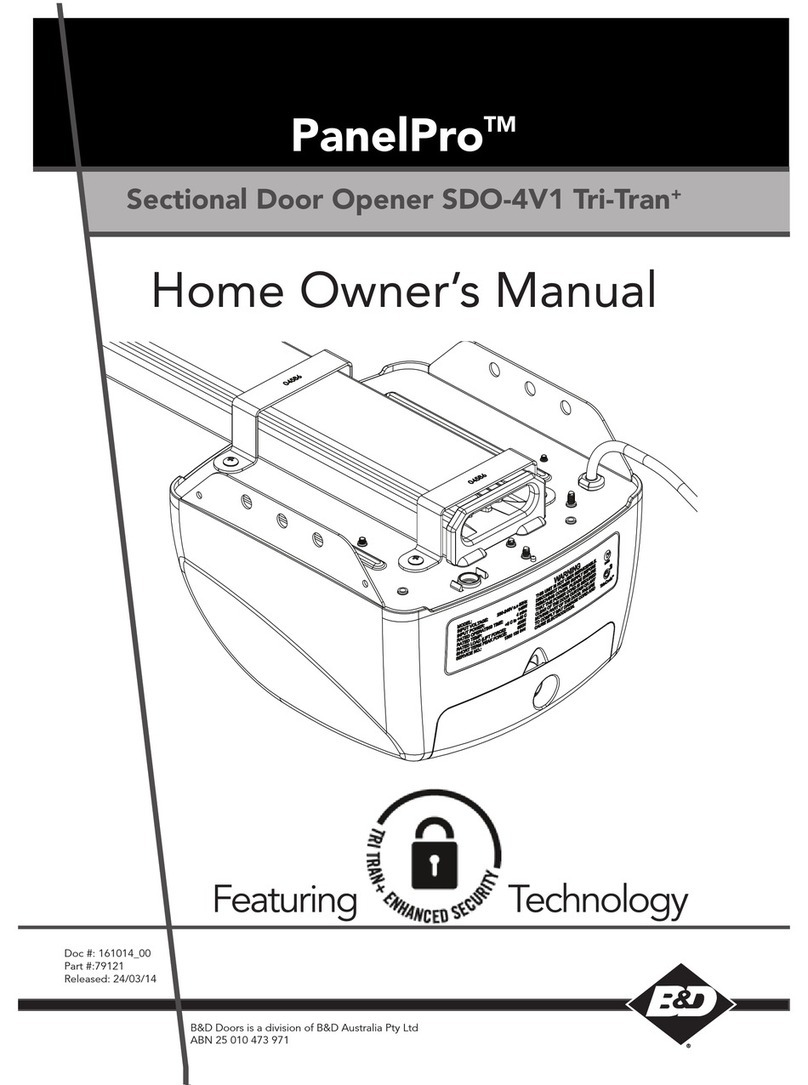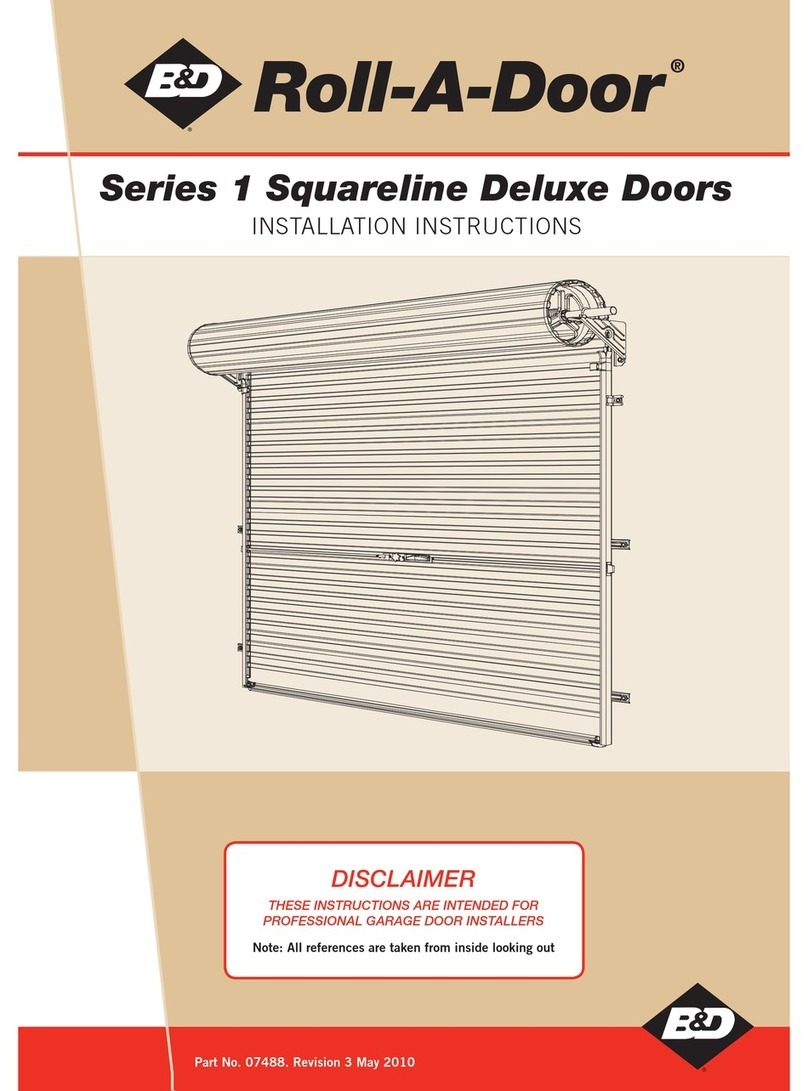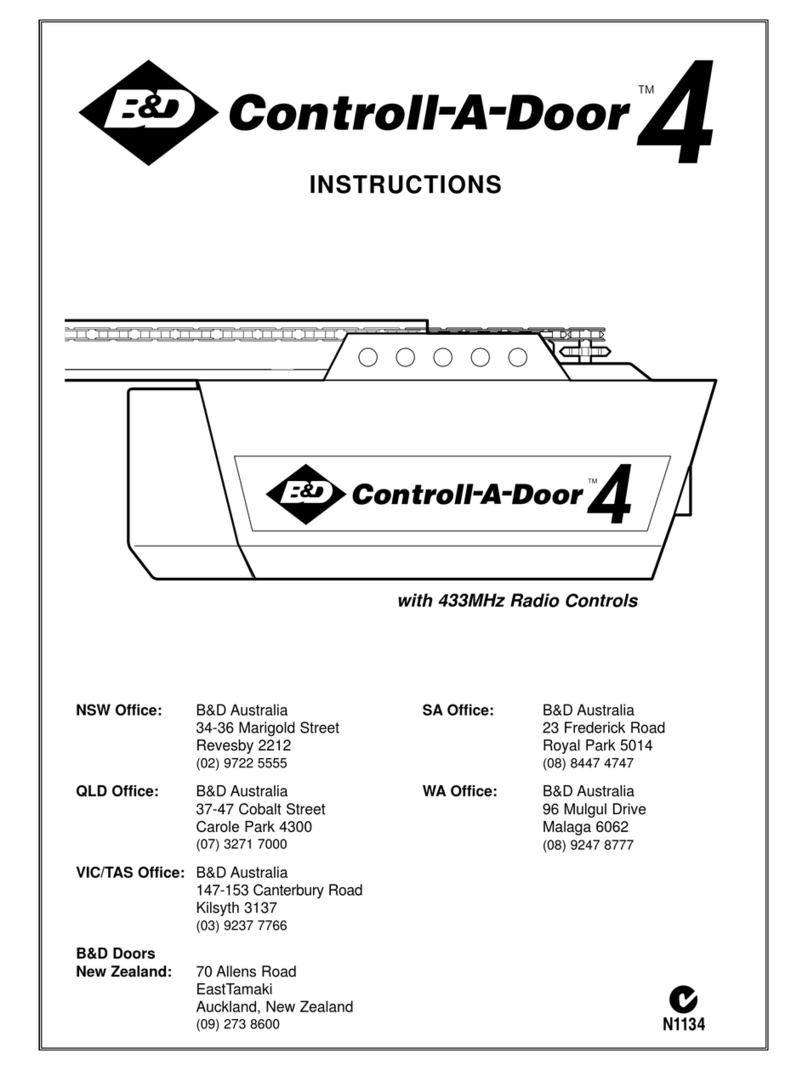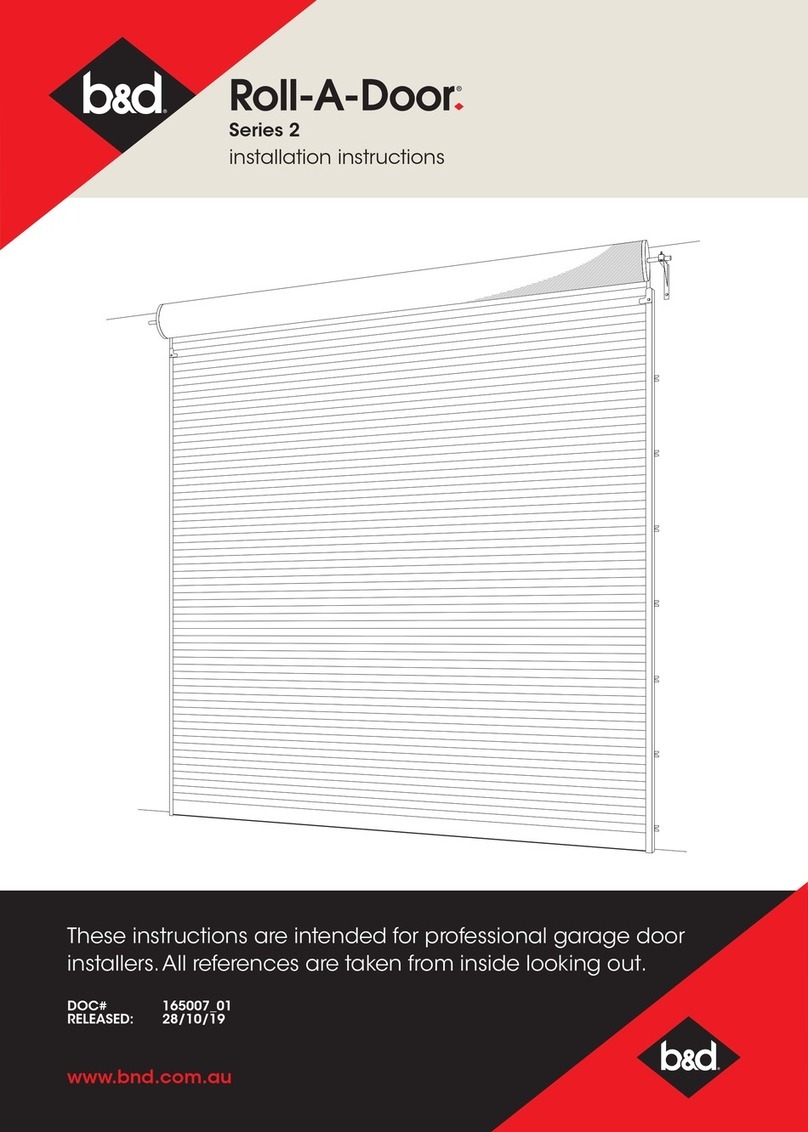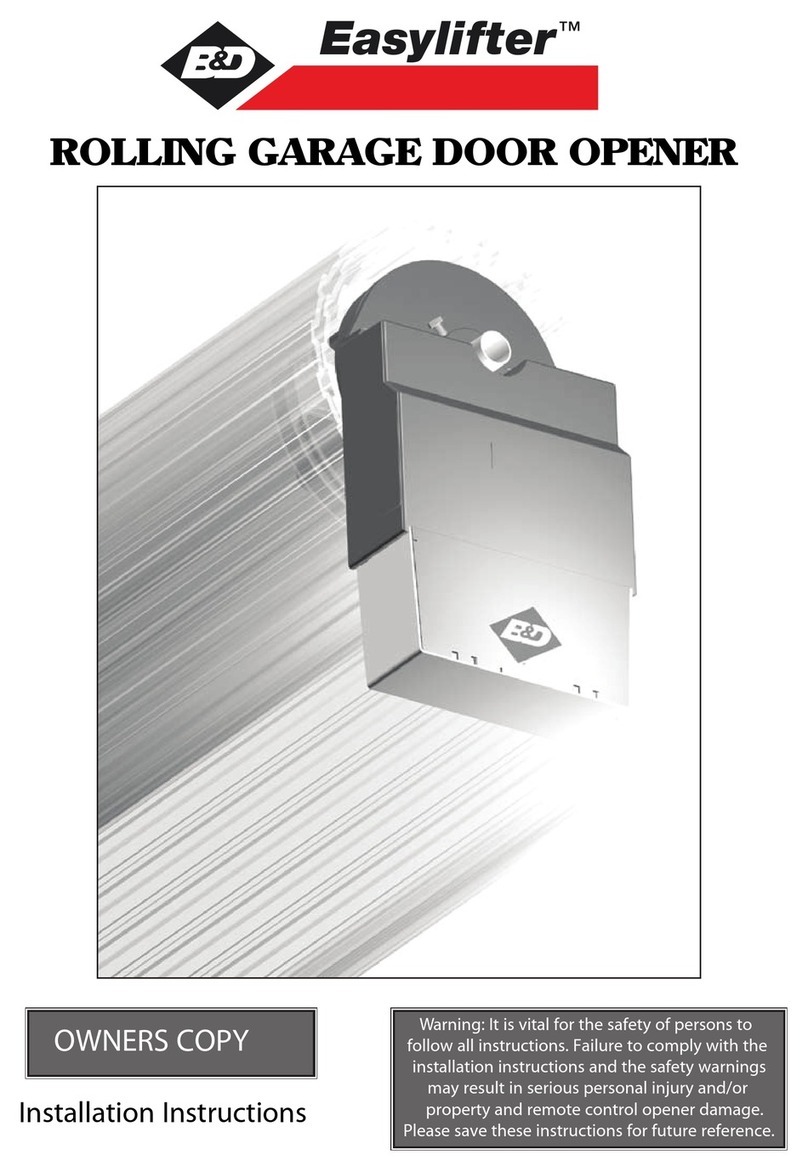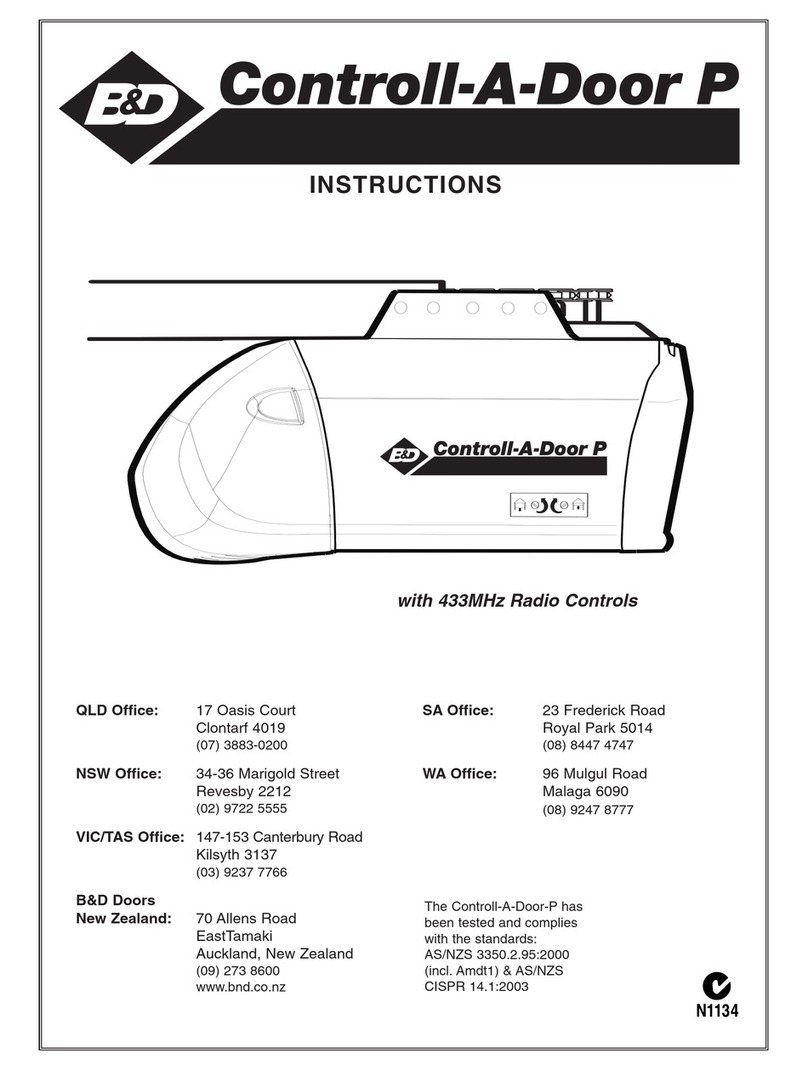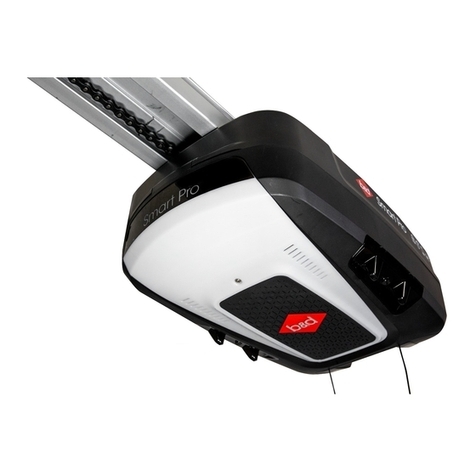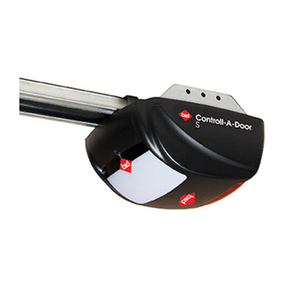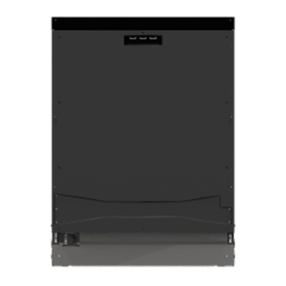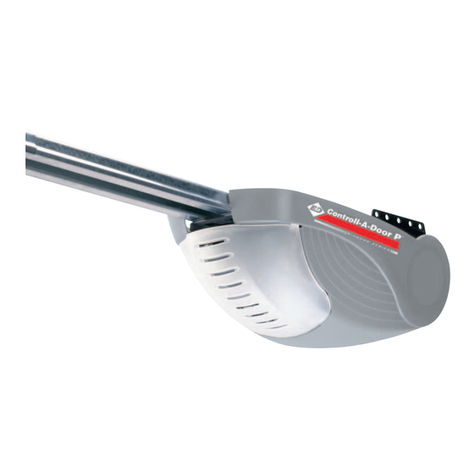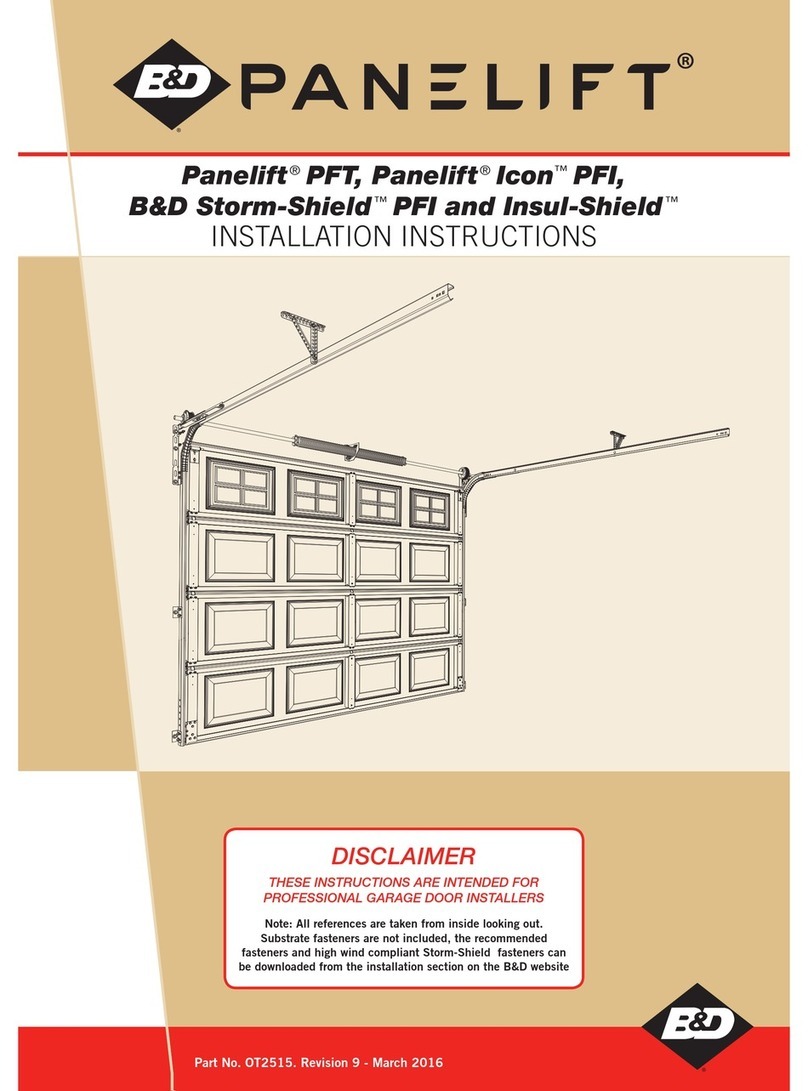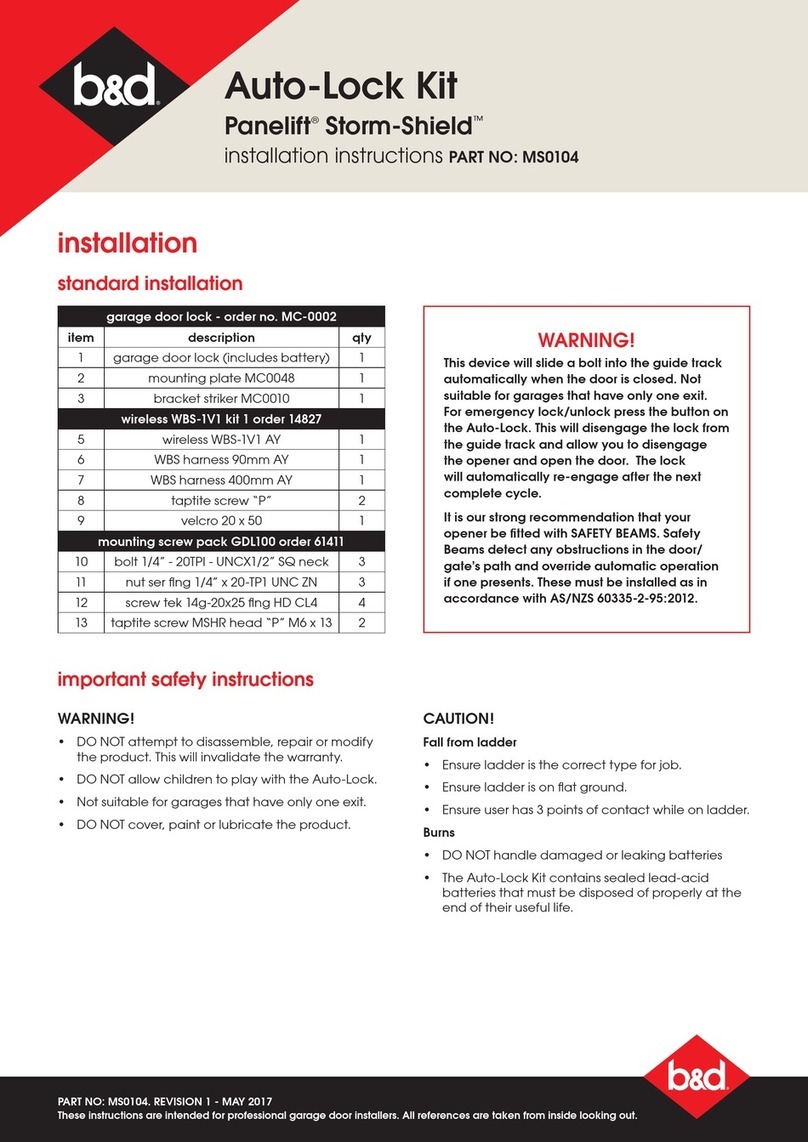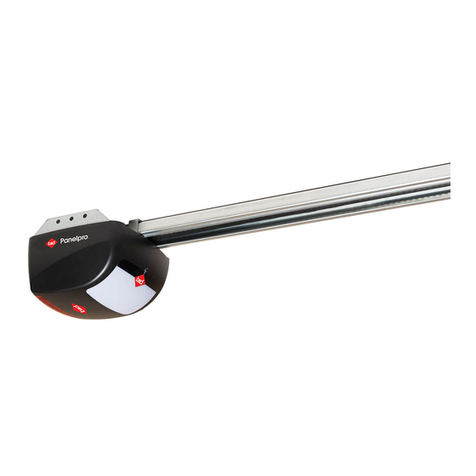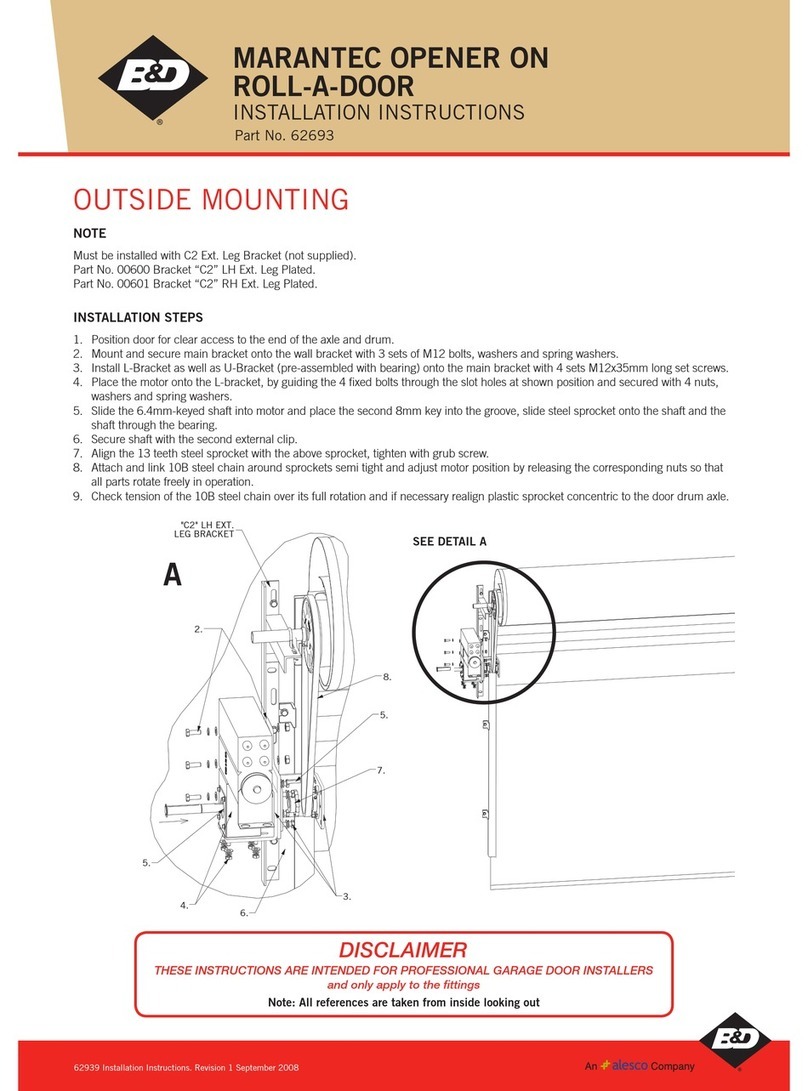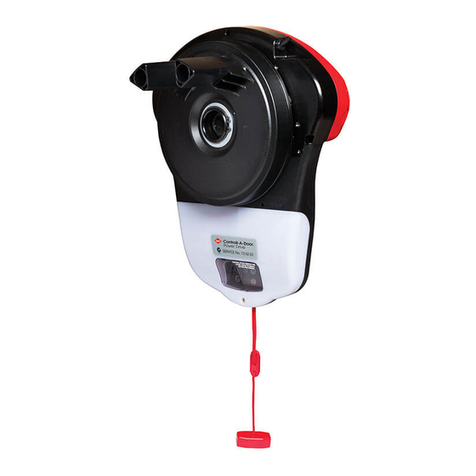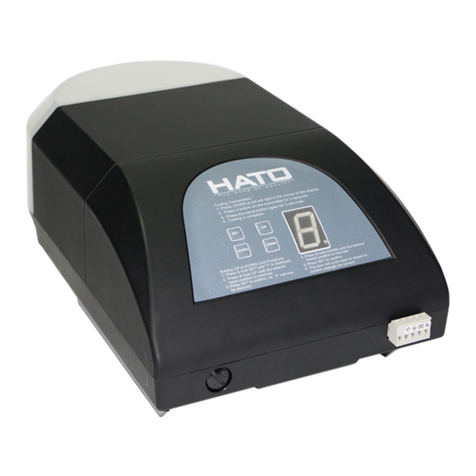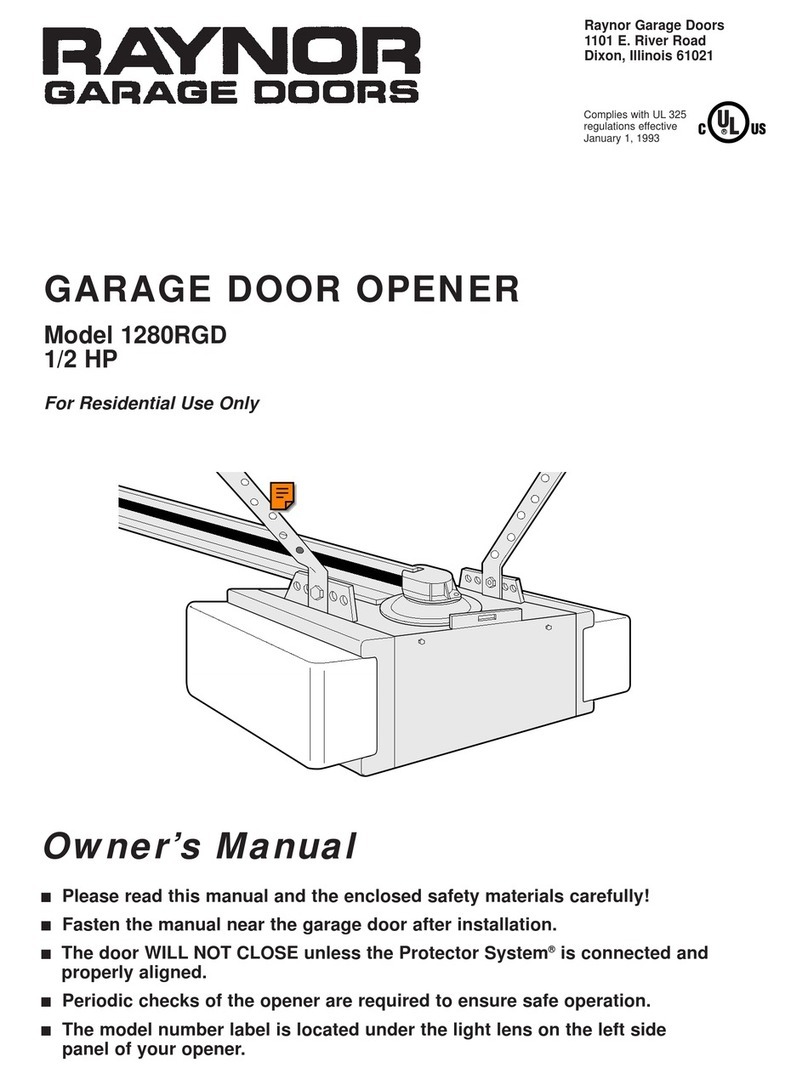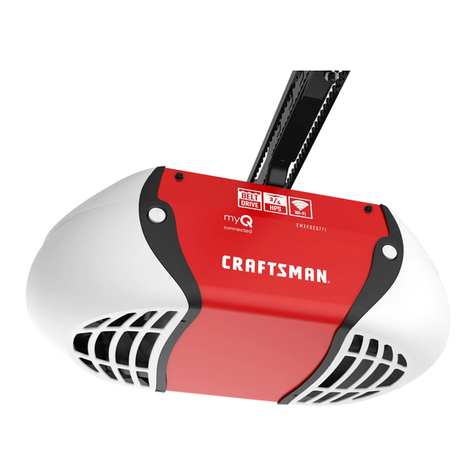1
17
14
16
To Increase Force Pressure
a. Hold down the FORCE MARGIN SET
button.
b. While holding the FORCE MARGIN SET
button, press the PLUS (+) button. Each
press will increases the force margin.
c. The OPEN LIMIT LED will flash each time
the PLUS (+) button is pressed to indicate
an increase in force.
d. If the OPEN LIMIT LED flashes
continuously when the PLUS (+) button
is being pressed, this indicates that
the maximum force setting has been
reached.
e. Test the force again as per Testing Close
Cycle and Testing Open Cycle.
To Recall Factory Set Force
a. Holding down the FORCE MARGIN SET
button and the LIMIT SET button for two
seconds.
b. Release both buttons. The default setting
should now be recalled.
Doc # 161009_00
Part # 79122
Released: 28/03/14
WARNING! • The door may operate unexpectedly, therefore do not allow anything to stay in the path of
the door.
• When operating the manual release while the door is open, the door may fall rapidly due
to weak or broken springs, or due to being improperly balanced.
• The drive must not be used with a door incorporating a wicket door, unless the drive cannot
be operated with the wicket door open.
• The drive is intended to be installed at least 2.5m above the floor.
• Do not disengage the opener to manual operation with children/persons or any objects
including motor vehicles within the doorway.
• If the door is closing and is unable to re-open when obstructed, discontinue use. Do not
use a door with faulty obstruction sensing
• When using auto close mode, a Photo Electric beam must be fitted correctly and tested
for operation at regular intervals. Extreme caution is recommended when using auto
close mode. All safety rules must be followed.
ELECTROCUTION! • Place opener in protected area so that it does not get wet.
• Do not spray with water .
• Disconnect the power cord from mains power before making any repairs or removing
covers. Only experienced service personnel should remove covers from the opener.
• If the power supply cord is damaged, it must be replaced by an Automatic Technology
service agent or suitably qualified person.
• Connect the opener to a properly earthed general purpose 240V mains power outlet
installed by a qualified electrical contractor.
CAUTION:
Emergency Access • If garage has no pedestrian entrance door, an emergency access device should be
installed. This accessory allows manual operation of the garage door from outside in case
of power failure.
Muscular strain • Practice correct lifting techniques (carton weighs approx 9kgs)
• Practice correct lifiting techniques when required to lift the door as per installation instructions.
Fall from ladder • Ensure ladder is the correct type for job.
• Ensure ladder is on flat firm ground that will take the weight without the legs sinking.
• Ensure user has 3 points of contact while on ladder.
Crush injury from unsecured
door
• Place a 2 metre exclusion zone around area under the door while it is unsecured.
• Do not move under a door while it is on the door support (or ladder)
• Follow the installation instructions
• Fit door support (or ladder) snugly under door before removing bracket.
• Ensure door support (or ladder) is on flat ground
Garage Door • Examine the door installation, in particular cables, springs and mountings for signs of wear,
damage and imbalance.
• The garage door must be well balanced. Sticking or binding doors must be repaired by a
qualified garage door installer prior to installation of the opener.
• Remove or disengage all garage door locks and mechanisms prior to installation of the
opener.
Entanglement • Never plug in and operate opener prior to installation.
• Keep hands and loose clothing clear of door and guides at all times.
Entrapment under
operating door
• DO NOT operate the opener unless the garage door is in full view and free from objects
such as cars and children/people. Make sure that the door has finished moving before
entering or leaving the garage
• In order for the opener to sense an object obstructing the door way, some force must be
exerted on the object. As a result the object, door and/or person may suffer minor damage
or injury.
• Ensure the garage door is in good working order by undertaking regular servicing.
• Install the optional wall transmitter in a location where the garage door is visible, but out
of the reach of children at a height of at least 1.5m.
• Photo Electric beams must be installed if the closing force at the bottom edge of the door
exceeds 400N (40kg)
This automatic garage door opener is designed and tested to offer safe service provided it is
installed and operated in strict accordance with the following safety rules. Failure to comply with
the following instructions may result in death, serious personal injury or property damage.
34-36 Marigold St, Revesby, NSW, Australia ABN 25 010 473 971
P: 13 62 63 W: www.bnd.com.au
WARNING! Take care when testing or adjusting the
Safety Obstruction Force. Excessive force may cause
SERIOUS PERSONAL INJURY and/or PROPERTY
DAMAGE.
Testing Close Cycle
a. Press the programmed transmitter to open the door.
b. Place a piece of timber approximately 40mm high on the
floor directly under the door.
c. Press the programmed transmitter to close door.
d. The door should strike the object and re-open.
Testing Open Cycle
a. Press the transmitter to close the door.
b. Press again to open the door.
c. When the door reaches approximately half way, firmly grab
the door’s bottom rail - the door should stop.
d. If the door does not reverse readily when closing, or stop
when opening, the force may be excessive and need
adjusting.
40mm block of wood
WARNING! If the door fails these tests, put the opener into
manual mode, only operate the door by hand and call for
service.
WARNING! Photo electric beams must be installed if the closing
force at the bottom edge of the door exceeds 400N (40kg) force.
NOTE: Once the travel limits are set and safety obstruction force tested check the chain or belt tension. As per the sticker on the C-rail the chain
or belt should sag slightly, so there is a 5mm gap between the bottom of the C-rail and the chain or belt.
The tension can be varied by using a spanner to adjust the bolt at the door end of the C-rail.
Be sure not to over-tension the chain or belt as this can cause damage to the C-rail or opener.
Adjusting Safety Obstruction Force
The Safety Obstruction Force is calculated automatically during setup. Adjusting this is normally only necessitated by environmental conditions
such as windy or dusty areas, and areas with extreme temperature changes.
Symptom Possible cause Remedy
The opener does not work
from the transmitter
Garage door in poor condition e.g. springs
may be broken
The opener does not have power
The battery in the transmitter is flat
Transmitter does not contain
Tri-Tran+Technology
The opener has been put into “Vacation
Mode”
The transmitter button is not programmed to
operate the door.
Door Code LED is flashing yet the opener is
not working.
Check the door’s operation
Plug a device of similar voltage (e.g. a hairdryer) into the
power point and check that it is OK
Replace the battery
Check that the transmitter has grey buttons and the model
number on the back displays V2. Contact dealer for support
if otherwise.
Turn off “Vacation Mode”
(Section 8.3, step e of Home Owners Manual)
Code in the transmitter
Ensure the correct button on the transmitter is being
pressed.
One transmitter works but
the other/s do not
Faulty transmitter
Flat battery
Replace transmitter
Replace battery
The chain moves but the
door remains stationary
The opener is disengaged Re-engage the opener
Motor is running but chain is
not moving
Damage motor assembly Contact your dealer for support.
The transmitter range varies
or is restricted
Variations are normal depending on
conditions e.g. temperature or external
interference
The battery life is exhausted
Position of the transmitter in the motor
vehicle
Make sure you can see the door when you use the
transmitter.
Check the battery status by pressing a button (flashing or no
light requires battery to be changed)
Aim the transmitter through the windscreen.
The Courtesy light does not
work
LED has failed Change LED.
The door reverses for no
apparent reason
This may occur occasionally from
environmental conditions such as areas that
are windy, dusty or have extreme temperature
changes.
If Safety beams are installed they may be
partially obstructed.
Ensure the door runs smoothly before increasing the force
pressure.
Ensure the beam path is not obstructed. Check the
Alignment.
Auto Close not working Safety Beam or wiring faulty Repair Safety Beam or replace wiring.
Re-align optics. See Safety Beam instructions.
The door stops or moves
very slowly under battery
(Optional Battery Back Up
Accessory)
The batteries may have little OR no charge Connect mains power and leave the batteries to charge. The
batteries may take 24 to 48 hours to reach their maximum
charge capacity.
The SERVICE LED has
started to flash and is
beeping numerous times
A Fault has been detected. The fault will
be active each time an attempt is made to
operate the door.
Record opener function (How many beeps?) then press the
SET button once to reset the opener. If the fault continues to
be tripped contact 13 62 63 for support.
The Open (Green) LED and
Close (Red) LED are flashing
alternatively
Opener is overloaded Check the doors operation by disengaging the motor and
ensuring the door runs smoothly. If necessary make door
adjustments or contact your door professional.
The Open (Green) LED
continues to flash
Door obstructed when opening Clear away any obstructions and test door opens correctly.
(If door is damaged, contact your door professionl).
The Close (Red) LED
continues to flash
Door obstructed when closing
Limits may be cleared
Clear away any obstructions and test door closes correctly.
(If door is damaged, contact your door professional).
Remove all power sources (including the battery backup).
Wait till all lights are out (10-15 secs), then reconnect power.
If Red LED is flashing, limits are not set. Reset Limits.
To Decrease Force Pressure
a. Hold down the FORCE MARGIN SET
button.
b. While holding the FORCE MARGIN SET
button, press the MINUS (-) button. Each
press will decrease the force margin.
c. The CLOSE LIMIT LED will flash each
time the MINUS (-) button is pressed to
indicate a decrease in force.
d. If the CLOSE LIMIT LED flashes
continuously when the MINUS (-) button
is being pressed, this indicates that the
minimum force setting has been reached.
e. Test the force again as per Testing Close
Cycle and Testing Open Cycle.
To Recalculate Force Margins
a. Press and hold the FORCE MARGIN
SET Button for six (6) seconds, the
beeper will sound once.
b. The door will start to move and re-
calculate force margins. The door can
move between the open and close
limit positions up to four (4) times
(depending on the position of the door
and the power up condition).
c. A single beep will be heard once the
process is complete.
d. Test the force again as per Testing Close
Cycle and Testing Open Cycle.
Safety Obstruction Forces Troubleshooting Guide
Tools Required
• Ladder
• Adjustable Wrench
• Socket set
• Drill
• Screwdrivers
• Marker Pen
• Door Stand
Important Note:
Only Tri-Tran+Technology Transmitters
and Keypads are compatible with this
SDO-2V2 product.
